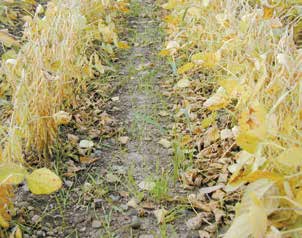chAPter 10 Cover CroPs
cover croP seLectIon And PLAnt PArAsItIc neMAtodes
If nematodes become a problem in your crops (common in many vegetables such as lettuce, carrots, onions, and potatoes, as well as some agronomic crops), carefully select cover crops to help limit the damage. For example, the root-knot nematode ( M. hapla) is a pest of many vegetable crops, as well as alfalfa, soybeans, and clover, but all the grain crops—corn, as well as small grains—are nonhosts. Growing grains as cover crops helps reduce nematode numbers. If the infestation is very bad, consider two full seasons with grain crops before returning to susceptible crops. The root-lesion nematode ( P. penetrans) is more of a chal enge because most crops, including almost all grains, can be hosts for this organism. Whatever you do, don’t plant a legume cover crop such as hairy vetch if you have an infestation of root-lesion nematode—it will actual y stimulate nematode numbers. However, sudan grass, sorghum-sudan crosses, and ryegrass, as well as pearl millet (a grain crop from Africa, grown in the U.S. mainly as a warm-season forage crop) have been reported to decrease nematode numbers dramatical y. Some varieties appear better for this purpose than others. The suppressive activity of such cover crops is due to their poor host status to the lesion nematode, general stimulation of microbial antagonists, and the release of toxic products during decomposition.
Forage millet; sudan grass; and brassicas such as mustard, rapeseed, oilseed radish, and flax all provide some biofumigation effect because, when they decompose after incorporation, they produce compounds that are toxic to nematodes. Marigolds can secrete compounds from their roots that are toxic to nematodes.
between the cover crop and the main crop. The seeds
vegetable–winter grain rotation sequence (figure 10.6c).
can be no-till drilled instead of broadcast, resulting in
Interseeding. The third management strategy is
better cover crop stands. We recommend against the use
to interseed cover crops during the growth of the main
of tillage prior to cover crop seeding, as it negates most
of the benefits of the cover crop. In milder climates, you
can usually plant cover crops after harvesting the main
a
winter grain
crop. In colder areas, there may not be enough time to
establish a cover crop between harvest and winter. Even
cover crop
if you are able to get it established, there will be little
growth in the fall to provide soil protection or nutrient
b
uptake. The choice of a cover crop to fit between main
early vegetables
early vegetables
summer crops (figure 10.5b) is severely limited in north-
ern climates by the short growing season and severe
cover crop
cover crop
cold. Winter rye is probably the most reliable cover crop
for those conditions. In most situations, there are a
c
early vegetables winter grain
range of establishment options.
cover crop
Cover crops are also established following grain harvest
in late spring (figure 10.6a). With some early-maturing
cover crop
vegetable crops, especially in warmer regions, it is also
January
July
January
July
January
possible to establish cover crops in late spring or early
Figure 10.6. Timing cover crop growth for winter grain, early vegetable, summer (figure 10.6b). Cover crops also fit into an early
and vegetable-grain systems.
109
Building SoilS for Better CropS: SuStainaBle Soil ManageMent





